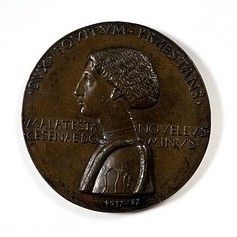Илюстрация 1 за Лекция на 14.12.2018
Илюстрация 1 за Лекция на 14.12.2018
In a study on Dante’s esoterism, René Guénon mentions two bronze medals, one portraying Dante and the other depicting the Veronese painter Pisanello. The reverse side of each medal bears the initials: F.S.K.I.P.F.T.found in the Victoria and Albert Museum Guénon interprets the initials as “Fidei Sanctae Kadosch Imperialis Principatus Frater Templarius” and argues that Fidei Sanctae refers to the “Fede Santa” a tertiary order of Templar association whose dignitaries bore the title of “Kadosch”. The latter is the Hebrew word for “consecrated” and is still used for some freemason grades. Guénon believes this was proof that Dante Alighieri was therefore connected to the Templars and this is why he chose Saint Bernard of Clairvaux as his guide in the third book of the Divina Commedia. Guénon states that the medals he saw were found in Vienna’s Historische Museum. However, a search of this museum’s current online catalogue does not return any of the two medals. The medal representing Pisanello, does appear in a Catalogue of bronzes and ivories of European origin shown by the Burlington Fine arts club in 1879. That catalogue ascribes the medal to Pisanello (1360-1415). Both Morelli and Gruyer believe that the medal is genuine; however, Milanesi and Lenormant believe that the medal was made by Francesco Corradini, not Pisanello, hence the inscription “Franciscus Korradini Pictor Fecit” (from the Lives of Painters by Giorgio Vasari, Blashfield and Hopkins edition, volume II). Luigi Valli, in his study Studi sui fidele d’amore, I, 1933, suggests that the inscription could refer to the seven virtues, Fides, Spes, Karitas, Justitia, Prudentia, Fortitudo, Temperantia. In his view, this could have held some initiatic meaning.


